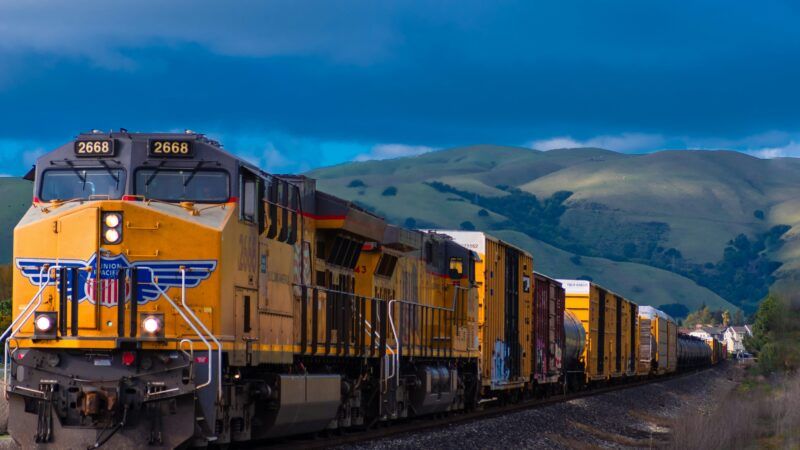No, Biden's New Rail Crew Mandate Doesn't Make 'Common Sense'
Requiring two-person crews on freight trains wouldn't have prevented the East Palestine disaster. It's simply a giveaway to Biden's labor union allies.

The 53-car freight train that derailed in East Palestine, Ohio, last year was operated by a crew of three men, none of whom were able to prevent the cascade of mechanical and communication failures that led to the unfortunate accident.
In response to that crash, the federal Department of Transportation announced on Tuesday a new policy requiring freight trains to operate with at least two-person crews—a mandate that the Biden administration says will enhance rail safety.
If you've passed first grade, you might now find yourself asking a rather basic question: Isn't three more than two?
Rest assured that it is. However, in Washington, the policy-making calculus often relies on fuzzy math that is heavily influenced by the pull of special interests and the strong sense of do-something-ism.
Both are on display in the new freight railroad mandate. The derailment in East Palestine was bad, and something must be done. This is something, so now it is being done—and bonus points can be scored because doing this specific thing will please the Biden administration's labor union allies, which have been lobbying the government for years to impose exactly this two-person crew mandate.
On Tuesday, Transportation Secretary Pete Buttigieg said it should be "common sense" that "large freight trains, some of which can be over three miles long, should have at least two crew members on board."
The length of the train has absolutely nothing to do with it, but Buttigieg is gesturing toward the idea that a second person on board could bring the train to a halt if the driver is somehow incapacitated. And, indeed, it was longstanding railroading practice to have multiple people in the cab of freight trains for exactly this reason.
These days, however, it is automation and not a backup engineer that is responsible for a dramatic decline in railway accidents and injuries. Thanks to positive train control (PTC)—essentially a computer-based override system that monitors speed and track signals to avert collisions, and which railroads have been mandated by Congress to use since 2008—rail accidents have fallen by 30 percent while employee injuries are down 40 percent since 2000, according to data from the Association of American Railroads (AAR), an industry group.
Additionally, Buttigieg's claim about "common sense" comports with neither the specifics of the East Palestine accident nor recent governmental reviews of the two-person crew mandate.
The Federal Railroad Administration spent three years investigating a proposed two-person crew mandate before concluding in 2019 that the rule was not "necessary or appropriate for railroad operations to be conducted safely," largely because of the safety gains already made by automation. More recently, Congress considered—but, notably, did not enact—a two-member crew mandate in the wake of the East Palestine derailment.
As for the the East Palestine incident, having a crew of 10 people driving the train likely wouldn't have made any difference. The crash was caused by an overheated wheel bearing, which failed and derailed the train as the crew was attempting to bring it to a stop. The three-person crew should have been alerted to the problem sooner, but at least one track-side detector meant to spot the wheel issue was not working properly.
Neither of those failures was the result of the crew on board the train, and neither point of failure would have been addressed by having additional crew members riding in the engine.
"Instead of prioritizing data-backed solutions to build a safer future for rail, FRA is looking to the past and upending the collective bargaining process," said Ian Jefferies, president and CEO of the AAR, in a statement about the new rules.
As Jefferies suggests, this looks a lot like a giveaway to the labor unions representing railroad employees. Going forward, they won't have to negotiate over how many crew members should have to be paid to sit in the engine of a freight train—they'll simply point to the federal regulation.
That will create some real costs for anyone shipping or receiving products via rail. A 2015 study funded by the AAR found that switching from two-person to one-person crews could save railroads $2.5 billion over a decade. Some of those savings are now likely to be consumed by the cost of paying for redundant crew members who don't make trains safer or more efficient.
"Railroad employee unions that promote these laws have two primary motivations. First, the unions fear that train automation technologies will, over time, replace their dues-paying members. Second, they'd like to have a government edict replace a matter that is normally subject to collective bargaining negotiations between the union and railroad management," wrote Marc Scribner, a senior transportation policy analyst at the Reason Foundation (which publishes this website), in 2021. "On the latter, it is quite rational for unions to lobby for government favoritism in labor-management relations. But on the former, forcing railroads to shoulder above-market labor costs in perpetuity is likely to ultimately backfire on union members by reducing rail's long-term competitiveness."
And if you're still not convinced that the two-member crew mandate has nothing to do with safety, here's one final thing to consider. Amtrak—which operates trains carrying human beings and therefore ought to be held to the highest scrutiny when it comes to safe operation—dropped its own two-member crew mandate over 40 years ago.




Show Comments (52)